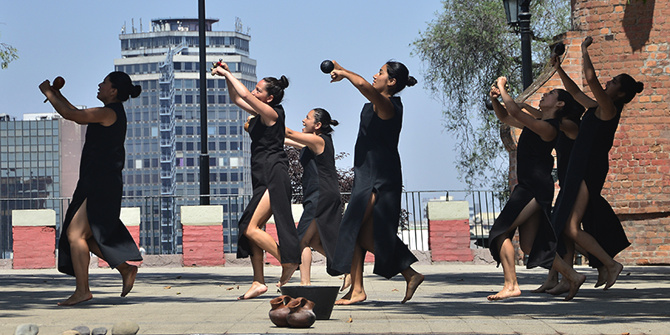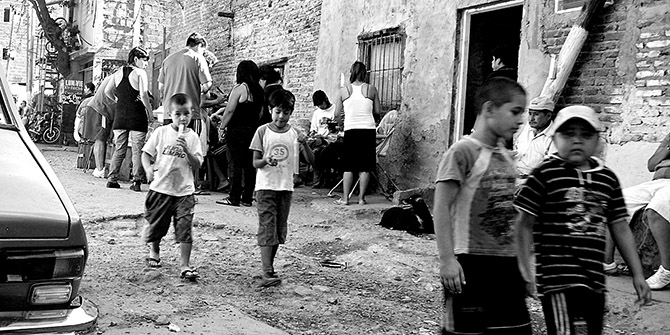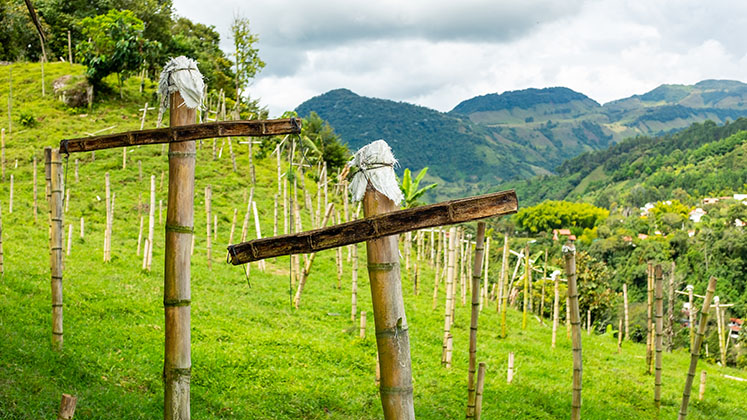 The romantic idea of death as the quintessence of Mexicanness masks real suffering in a country where senseless death has become commonplace, writes Myriam Lamrani.
The romantic idea of death as the quintessence of Mexicanness masks real suffering in a country where senseless death has become commonplace, writes Myriam Lamrani.
In Mexico everyday acts of drug violence are often obscured by the pervasiveness of a poetic view of death. Since the beginning of the drug war in 2006, hundreds of thousands people have been killed and disappeared in Mexico. The untold story is that the violence also reaches beyond those directly connected with drug trafficking and into wider society. One clear example is the cult of the female skeleton figure Santa Muerte (Saint Death). Despite being associated with “narco-culture”, her popularity has grown steadily over the past decade. By looking at this representation of death and its aesthetics in Oaxaca de Juárez, a city known for its flamboyant Day of the Dead celebrations, we can explore the idea of intimacy with death as it moves from popular religion to the politics and the poetics of everyday life.
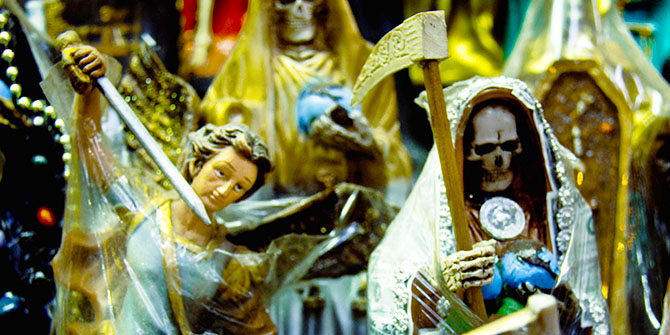
Day of the Dead is a three-day celebration that involves people gathering in cemeteries to honour and remember their dearly departed. Drawing on these festivities and on artistic representations of death in Mexico, post-revolutionary intellectuals fostered the enduring idea that Mexicans maintain a humorous relationship with death. In The Labyrinth of Solitude, the poet and Nobel laureate Octavio Paz writes: “the Mexican chases after death, mocks it, courts it, hugs it, and sleeps with it. He thinks of it as his favourite plaything and his most lasting love”. In researching the emergence of Santa Muerte devotion, I expected to uncover yet another facet of this alleged familiarity. Instead, I discovered that thinking poetically about death in Mexico has become far more problematic.
In spite of electing one of the safest Mexican states at the time to carry my research, my first contact with local anthropologists in Oaxaca de Juárez was disheartening. I was promptly given the once-over and warned, “it’s not safe; you should abandon your research”. The tone was set. The Zetas cartel had moved in to town and Oaxaca state had become the epicentre of an escalating turf war. In the words of one informant, if I went around investigating a so-called “narco saint”, I would never know who I was talking to, and I could end up in danger. However, the attraction of researching Santa Muerte was precisely this coalescence of a poetic, aesthetic vision of death with the lived reality of rampant violence of a drug economy stimulated by neoliberal reforms and insatiable demand from the United States.
As I pressed on with my fieldwork, my everyday experience uncovered ever more nuanced and contrasting evidence of this interplay. One minute I would be reading about Central American migrants losing life and limb as they crossed Mexico on a freight train known as The Beast, the next I would stumble on a joyful display of multi-coloured dancing skeletons put on for tourists. As the afternoon progressed a young woman would describe to me the bodies hanging from the bridges of her home town for days on end as a macabre message from the cartels to their enemies. Later, I would observe as devotees lovingly rearranged the flowers at shrines to Santa Muerte. Come dusk and no one would boast about violent death in the family. Ask the woman from Mérida who recounted how her brother was shot dead at his cantina in Guadalajara, adding serenely that the family would avenge his death. It was like being in a strangely muted war zone where the bullets fly but never hit you.
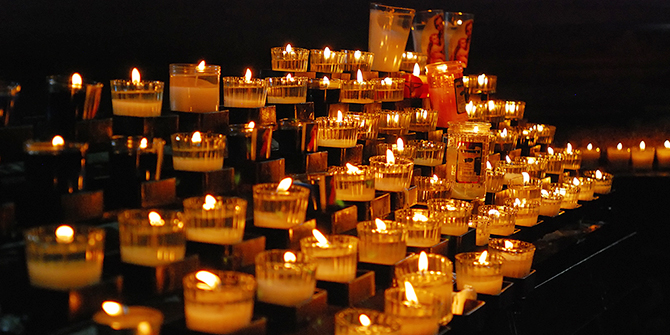
Thus, the Mexican’s happy relationship with death exalted as part of the national image did not stand up to scrutiny in the face of people’s lived experience. Rather, the discourse of death as the quintessence of Mexicanness suppresses the suffering of people damaged by the reality of a country where senseless death has become commonplace. This almost jocular intimacy with death sells a colourful vision of Mexico to the dazzled foreigner, but it fails to take into account the bleak socio-political situation of the country today.
The reality is that violent death does not discriminate: it is as painfully irrational in Mexico as it is anywhere. After a year researching the cult of Santa Muerte in Oaxaca, it was time to contact friends and informants to say goodbye, but there was one who didn’t pick up the phone. With a feeling of mounting dread, I took my computer and typed his name into a search engine. I was not prepared for the outcome: a series of sensationalist crime stories with graphic photos of my friend’s bruised, tortured, and beheaded body lying across one of the roads out of Oaxaca. There is nothing to celebrate about his death or about the fact that his friends and family will pay tribute to him at his grave in years to come. Sadly, he is just another casualty of the drug trade and the alarming violence seizing the country and ravaging the lives of so many Mexicans.
Our thinking about the poetics and the politics of death in contemporary Mexico needs to take into account the complexities of its modernity, both in terms of its position vis-à-vis the United States and the related expansion of the drug trade. The reality of death in Mexico means that the idea has lost its lyrical power. A much-vaunted playful intimacy now seems like bravura, an attempt to tame death itself, to keep it far from your own door.
Octavio Paz was undoubtedly one of the greatest poets that Mexico has ever produced, but in today’s Mexico his understanding of death is all too poetic. In his own words: “there can be no society without poetry, but society can never be realised as poetry, it is never poetic. Sometimes the two terms seek to break apart. They cannot.”
Notes:
• The views expressed here are of the authors rather than the Centre or the LSE
• Please read our Comments Policy before commenting


